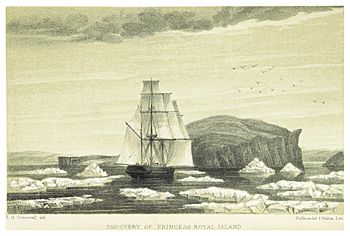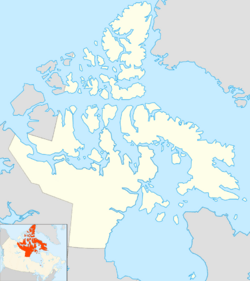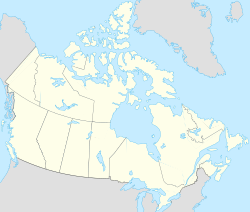Princess Royal Island (Nunavut) facts for kids

Extracted image of the island from page 179 of The Discovery of the North-West Passage
|
|
| Geography | |
|---|---|
| Location | Northern Canada |
| Coordinates | 76°56′N 094°19′W / 76.933°N 94.317°W |
| Archipelago | Queen Elizabeth Islands Canadian Arctic Archipelago |
| Area | 11 km2 (4.2 sq mi) |
| Administration | |
|
Canada
|
|
| Territory | Nunavut |
| Region | Qikiqtaaluk |
| Demographics | |
| Population | Uninhabited |
Princess Royal Island is a small, uninhabited island located in the far north of Canada. It is part of the Canadian Arctic Archipelago, a huge group of islands in the Arctic Ocean. This island is found in the territory of Nunavut.
Princess Royal Island sits in a body of water called Norwegian Bay. It is only about 3 kilometers (1.9 miles) away from the northeast coast of a much larger island, Devon Island.
Contents
Where is Princess Royal Island?
Princess Royal Island is located in the very northern part of Canada. It is one of many islands that make up the vast Canadian Arctic. This area is known for its cold climate and unique landscapes.
Part of the Arctic Archipelago
The island is a small piece of the Canadian Arctic Archipelago. This archipelago includes thousands of islands. It stretches across the Arctic Ocean. Many of these islands are covered in ice and snow for most of the year.
Princess Royal Island is also part of the Queen Elizabeth Islands. This is a specific group of islands within the larger Arctic Archipelago. These islands are some of the most northern landmasses in the world.
Nearby Islands and Waters
The island lies within Norwegian Bay. This bay is a large inlet of the Arctic Ocean. It is surrounded by several other important islands.
The closest large landmass is Devon Island. Devon Island is one of the largest uninhabited islands on Earth. It is a very cold and barren place. Princess Royal Island is just a short distance from its shores.
What is the Island Like?
Princess Royal Island is quite small, covering an area of about 11 square kilometers (4.2 square miles). To give you an idea, that's roughly the size of a small town. Like many Arctic islands, it is uninhabited by people.
Climate and Environment
The climate on Princess Royal Island is extremely cold. It experiences long, dark winters and short, cool summers. The ground is often frozen solid, a condition known as permafrost.
The landscape is likely rocky and barren. There might be some low-growing plants like mosses and lichens. These plants are adapted to the harsh Arctic conditions.
Wildlife and Nature
Even though no people live on Princess Royal Island, it might be home to some Arctic wildlife. Animals like polar bears sometimes travel across the sea ice. They hunt for seals in the surrounding waters.
Various seabirds might nest on the island's cliffs during the summer. Small Arctic mammals, such as Arctic foxes, could also be present. These animals are well-adapted to survive in the cold.
How Did it Get Its Name?
Many places in the Arctic were named during early explorations. These expeditions often named new discoveries after members of royal families or important figures.
The name "Princess Royal Island" suggests it was likely named in honor of a princess. This was a common practice during the 18th and 19th centuries. Explorers from countries like Britain often named features after their royalty.



